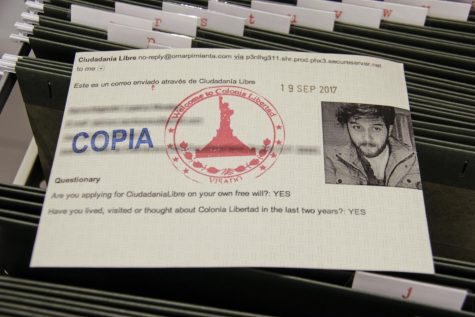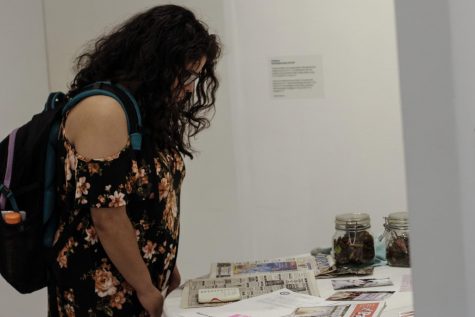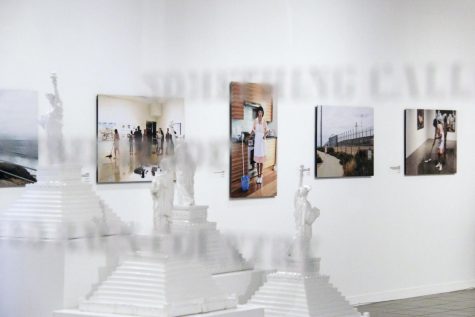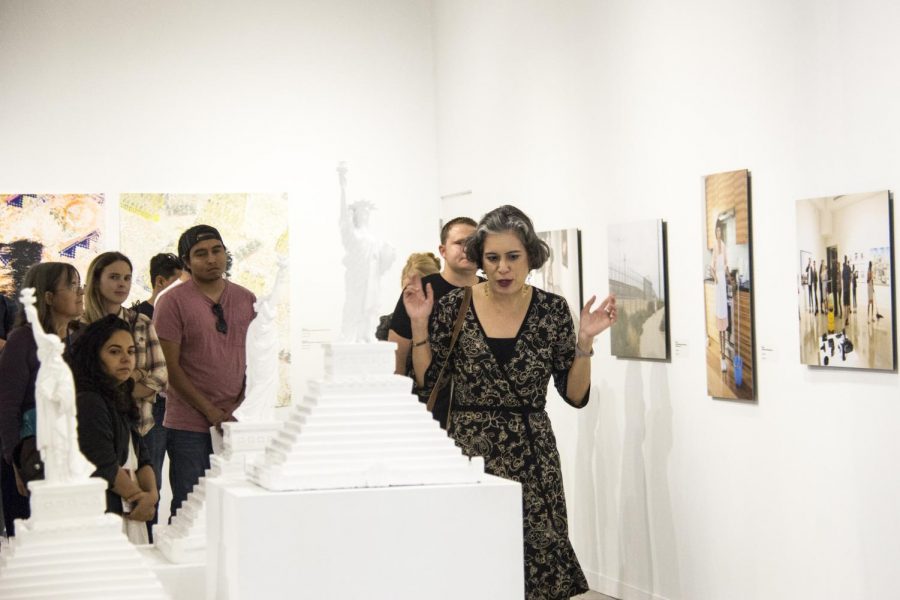Artists create “Undocumenta” experience
Art exhibit “goes beyond borders” to capture border struggles
Undocumenta’s curator Alessandra Moctezuma gives an exhibition tour at Oceanside Museum of art on Nov. 5.
December 5, 2017
Undocumenta, an exhibition at the Oceanside Museum of Arts (OMA) presents the work of six artists and their interactions with border life.
The name is wordplay. The exhibition challenges the art world elite by including the word “Documenta,” the name of an exhibition held every five years in Germany that showcases the work of international artists.
The title also refers to the word “undocumented,” one of the adjectives used to label people who cross the border unlawfully. The exhibition aims to capture how each artist sees the border or experiences it.
This project started last year when Alessandra Moctezuma, Undocumenta’s curator, wanted to showcase the work of different artists who work in the border region and the connections of the border with immigration and labor.

Undocumenta is an art exhibition that highlights issues that happen in the border region such as invisible labor, immigration, and border crossing.
Some of the featured artists are:
Omar Pimienta, who has a display called “Welcome to Colonia Libertad”, where he offers a “Consulado Móvil,” or Mobile Consulate. Pimienta challenges the concept of nationality by granting a free “citizenship” passport to Colonia Libertad in exchange for a real one that becomes a permanent part of the exhibit.
Ana Teresa Fernández’s “Borrando la Frontera,” or Erasing the Border, is a video where the artist symbolically erases the border. She paints fractions of the Mexican-American border wall, on the Mexican side, with similar colors from the surrounding, creating the illusion there is an opening in the wall.
Claudia Cano is a performance artist who portrays Rosa Hernandez, “La Chacha”, or the Cleaning Lady. Cano dresses as a maid with a bright pink uniform and cleans or sweeps the space she’s in, bringing out the shadows from the people who keep those places tidy. She also only speaks in Spanish while in character.
Teresita De la Torre wore a shirt she found in the desert for 365 days. She has a picture from a different place, taken on each day she wore it. She followed up with a series of drawings where she wrote about the experience of wearing it for all that time.
The planning of the exhibition began before then candidate Donald Trump demanded that a another wall be built along the entire Mexico-U.S. border.
The curator added that Undocumenta became “an artistic barricade” and added “the relevance of the show has increased because of the Trump administration.”

Kimberly Castañeda,19, a student from San Marcos State University looking at the cleaning appliances, letters, and so on, the artist Claudia Cano has used while impersonating Rosa Hernandez on Oct. 15.
Kimberly Castañeda,19, a student from San Marcos State University, said “I didn’t expect something to relate to me, like, too close like she is.” She added that her mother and grandmother worked cleaning houses.
“People should come up here and notice, notice Latinos; what it’s happening, especially how they are building a new wall” and said people should be aware of “the ignorance that is happening right now towards people like my parents.”
Moctezuma said the way everyone talks about the border is oversimplified and added that Undocumenta allows viewers “to imagine a different future.”

Documentation of a Free Citizenship passport from the Omar Pimienta’ Mobile Consulate at Undocumenta’s exhibition on Oct. 15.
The show is part of Pacific Standard Time: LA/LA, “a celebration beyond borders” that focused on visual art that explores the dialogue of Los Angeles with Latin American and Latino art. There are more than 80 art spaces across Southern California participating.
Local participating institutions include the Museum of Contemporary Art San Diego, Museum of Photographic Arts, San Diego Museum of Art, Mingei International Museum and University Galleries and the University of San Diego.
The exhibition has bilingual tours and special events and will be at the Oceanside Museum of Art until Jan. 28 of next year.
General Admission is $8 and $5 for seniors. Free admission for students, children under 18 and military and their dependants.












